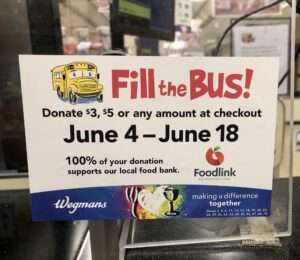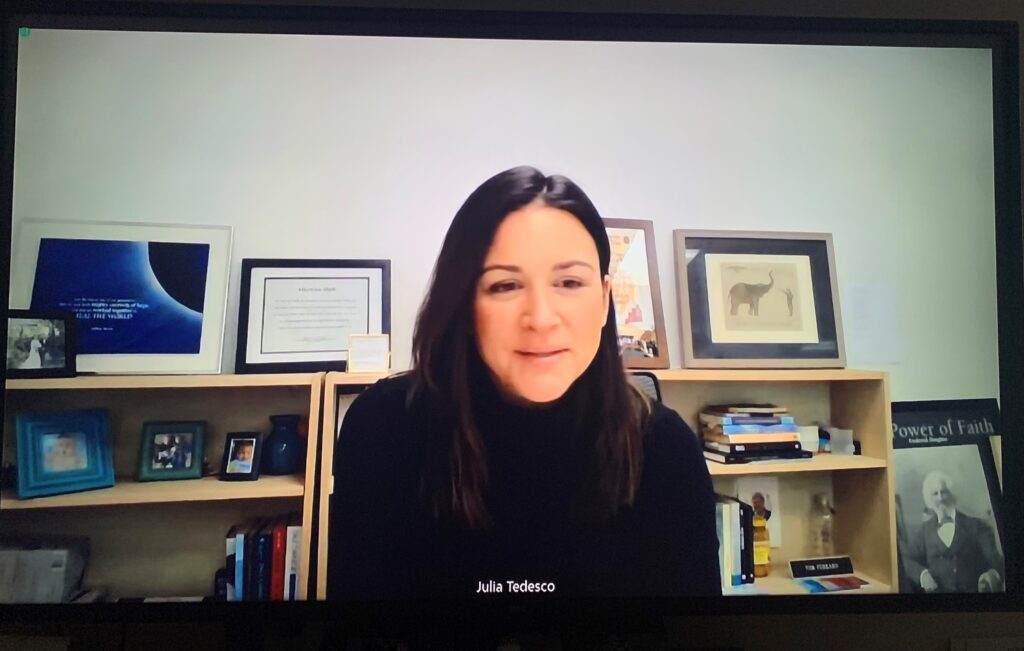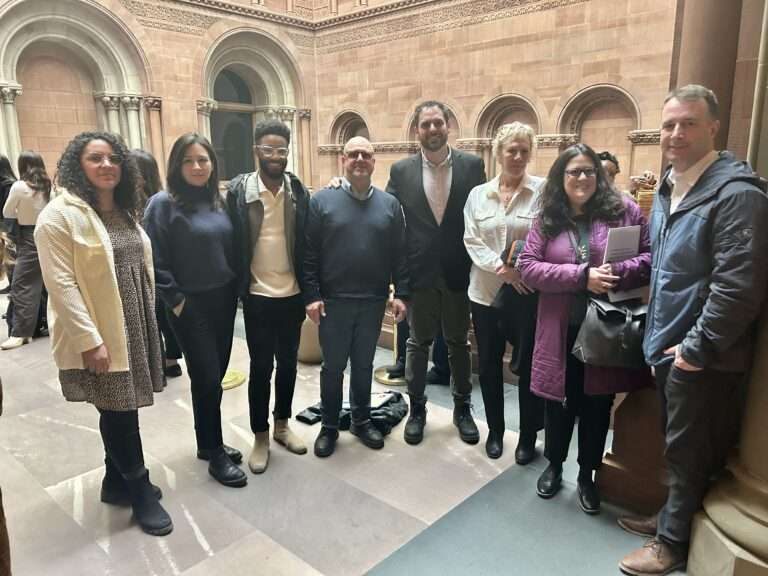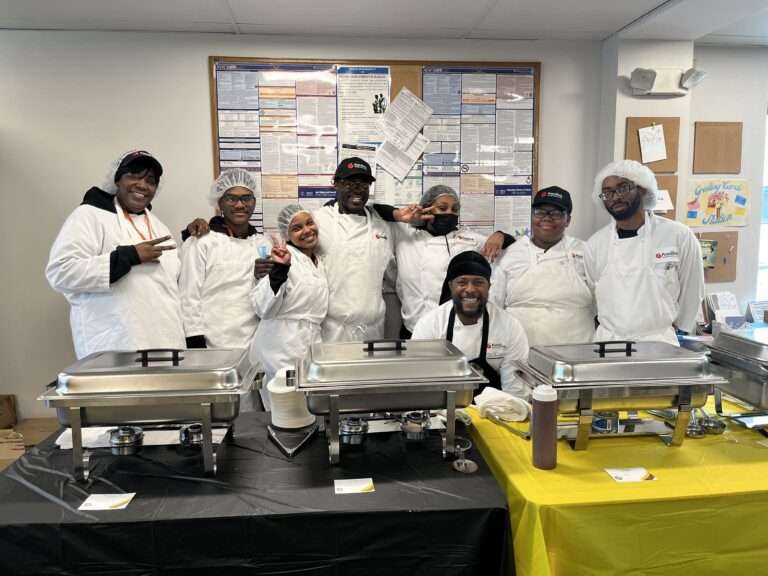The following testimony was given by Foodlink President & CEO, Julia Tedesco, on Jan. 19, 2022, at the House Rules Committee’s subcommittee hearing on Legislative & Budget Process.
Chairman Morelle, Ranking Member Burgess and members of the Rules Committee: Good morning, and thank you for the opportunity to speak with you today. My name is Julia Tedesco and I have the great privilege of serving as the president & CEO of Foodlink, a nonprofit organization in Rochester, NY, that serves as the regional food bank for 10 counties.
Congressman Morelle likely recalls attending Foodlink’s very first COVID emergency response food distribution on March 20, 2020, in his hometown of Irondequoit. There was a lot we didn’t know about COVID then, but as an emergency-response organization, we knew that families were already struggling to access food, as they do in the face of any crisis. That day, a collaboration between the nonprofit and government sector enabled us to safely get food to more than 300 households. In the two years since, we have organized more than 900 similar drive-through emergency food distributions across our region.
VIDEO: Watch the replay of the hearing
In the next few minutes, I’d like to first share details about Foodlink’s response during the pandemic. And second, I’d like to talk about critical role that nonprofits play and why investment in this sector will help prepare us for any future emergency response. In doing so, I will do my best to represent the 200+ Feeding America food banks across the nation that have responded to COVID-19 and countless other disasters.
Much attention has been given to the pandemic’s devastating impact on the food security of millions of families and on how just how many Americans were one crisis away from not having enough food to eat.
We saw this firsthand in the City of Rochester, and in the suburban and rural communities throughout our service area. We saw that as many as 40% of the people seeking support from the emergency food system were doing so for the very first time.
We also saw firsthand how this pandemic disproportionately impacted the vulnerable – the elderly with limited incomes, low-income parents, people of color, and so on. Individuals who were already facing difficult choices, like paying for rent or paying for food. Individuals for whom panic shopping in bulk for groceries was simply not an option.
At the same time, schools closed indefinitely. The City of Rochester has one of the highest child poverty rates in the nation. Every student in the district is categorically eligible for free school meals. With schools closed, parents were left wondering how to account for two extra meals, per child, per day—a looming financial and public health crisis of its own.
Foodlink sprang into action on both fronts.
In response to the need, we—within a matter of weeks — established a temporary, alternate off-site warehouse to safely store and pack emergency provisions. When most of our network of direct service partners – think of food pantries in community centers and church basements–were forced to shut down, we designed and coordinated no-touch, drive through distributions in centralized locations across a 7,000-square-mile region.
When government and community partners had critical information or supplies they needed to get to the public, we utilized these distributions to disseminate them. We became a central hub for everything from suicide prevention and mental health resources, to U.S. Census data collection.
When a nurse from our regional health care system called us frantically to figure out how to get food to an elderly, quarantined, immuno-compromised patient, we – for the first time in our 40+ year history – made a home delivery, and continued doing so thanks to partnerships with other nonprofits.
We sat with leaders from our local City school district to brainstorm and coordinate the logistics of 17 grab-and-go meal sites for kids and their families. Understanding that barriers still existed for food access, we repurposed some of our smaller trucks and – thanks to waivers issued by the USDA – implemented ice cream truck-style neighborhood meal distributions to complement our Summer Meals program.
Foodlink distributed more than 50 million pounds of food in the last 22 months, and our kitchen produced more than 1.5 million healthy meals and snacks. Our fellow food banks in New York State and around the nation all did similar work, distributing unprecedented amounts of nutritious food, leveraging our relationships in the communities we serve, expertise in food distribution, and our infrastructure – including distribution centers, industrial freezers and coolers, commercial kitchens, and fleets of trucks.
Significant government interventions, such as child tax credits and boosts in SNAP benefits helped quell what surely would have been devastating poverty levels. Still, food insecurity remains approximately 10% higher than the levels recorded in 2019. In our region, that equates to about 150,000 people who have limited access to food, or who might not know when or from where their next meal will come.
As a food bank, we are proud of our response to this pandemic – but it is important to emphasize that for every one meal that a Feeding America food bank provides, SNAP provides nine meals. If we are to make a meaningful reduction to hunger in America and address a compounding factor in any crisis, the federal government must continue to increase investments in anti-poverty programs like SNAP, and to think of this in its own way as a form of disaster preparedness.
In addition to investing in the social safety net, the federal government should more significantly invest in the non-profit sector’s ability to respond to crises.
Nonprofits are not merely a group of small charities trying to do good. We are oftentimes the engine that generates innovative solutions to complex problems in our society. When the government needed to find ways to distribute food, PPE, vaccines, and information into underserved communities, it relied on the infrastructure, expertise, and flexibility of community-based nonprofit organizations.
Far too often, though, nonprofits like Foodlink are asked to execute on programs that we did not have an opportunity to weigh in on. Issues with the Coronavirus Food Assistance Program have already been well-documented, and I won’t go into all of them here for the interest of time. But I hope a major lesson from CFAP is that when the federal government needs to find ways to help feed people, it should include — or perhaps begin with – the nonprofit sector, and specifically the expertise of the Feeding America network, rather than recreate the wheel.
This nation already has a centralized hub for emergency food assistance – with spokes across every state, county, and local community in America, that could have helped to ensure smoother logistics and equitable access to these food boxes. If food banks were included from the start – and leveraged for their expertise, we could have significantly reduced staff time spent on coordination, saved dollars, and fed millions more Americans.
I hope that a critical lesson to come out of the pandemic is the importance of investing in nonprofit infrastructure and technical capacity. Over the last couple of years, we often found ourselves with a strong food supply, but insufficient cold storage and refrigerated vehicles. Foodlink has had rented tractor trailers stationed in our parking lot, running 24/7 for 2 years, to provide additional cold storage.
Community-based nonprofits do not have the resources to do R&D and invest in innovation the way that the private sector does, and when we do it rarely, if ever, is funded by the federal government. We are encouraged by the USDA’s promised investments in strengthening our food system, and hope that those investments extend beyond farmers, producers, and for-profit distributors to include the non-profit sector.
To summarize: We first and foremost believe that our nation’s social safety net must be strengthened to better prepare us for the next disaster. But the pandemic has also shown us that the federal government has a real stake in the operational efficiency, infrastructure and capacity, and innovation of the nonprofit sector, especially when responding to disasters. This sector should be invested in, and nonprofits should be counted on not only to receive support and deliver interventions or services decided on by government, but to take part in the very design of those services.
Thank you for your time today.






